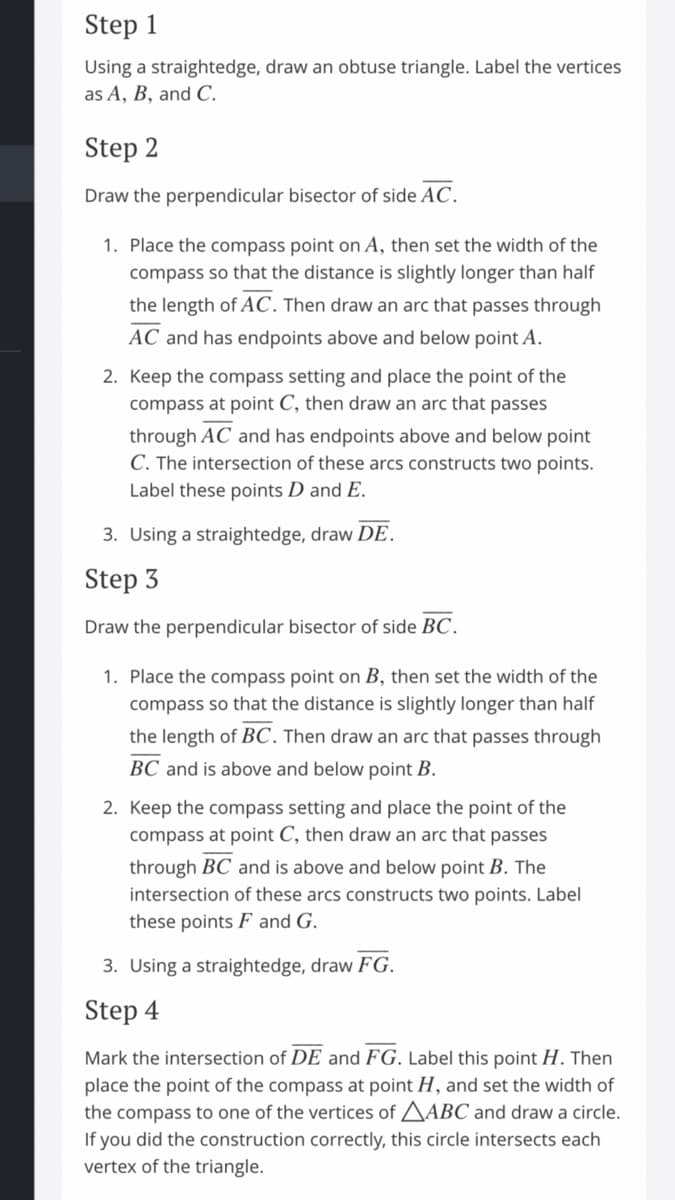Step 1 Using a straightedge, draw an obtuse triangle. Label the vertices as A, B, and C. Step 2 Draw the perpendicular bisector of side AC. 1. Place the compass point on A, then set the width of the compass so that the distance is slightly longer than half the length of AC. Then draw an arc that passes through AC and has endpoints above and below point A. 2. Keep the compass setting and place the point of the compass at point C, then draw an arc that passes through AC and has endpoints above and below point C. The intersection of these arcs constructs two points. Label these points D and E. 3. Using a straightedge, draw DE. Step 3 Draw the perpendicular bisector of side BC. 1. Place the compass point on B, then set the width of the compass so that the distance is slightly longer than half the length of BC. Then draw an arc that passes through BC and is above and below point B. 2. Keep the compass setting and place the point of the compass at point C, then draw an arc that passes through BC and is above and below point B. The intersection of these arcs constructs two points. Label these points F and G. 3. Using a straightedge, draw FG. Step 4 Mark the intersection of DE and FG. Label this point H. Then place the point of the compass at point H, and set the width of the compass to one of the vertices of AABC and draw a circle. If you did the construction correctly, this circle intersects each vertex of the triangle.
Step 1 Using a straightedge, draw an obtuse triangle. Label the vertices as A, B, and C. Step 2 Draw the perpendicular bisector of side AC. 1. Place the compass point on A, then set the width of the compass so that the distance is slightly longer than half the length of AC. Then draw an arc that passes through AC and has endpoints above and below point A. 2. Keep the compass setting and place the point of the compass at point C, then draw an arc that passes through AC and has endpoints above and below point C. The intersection of these arcs constructs two points. Label these points D and E. 3. Using a straightedge, draw DE. Step 3 Draw the perpendicular bisector of side BC. 1. Place the compass point on B, then set the width of the compass so that the distance is slightly longer than half the length of BC. Then draw an arc that passes through BC and is above and below point B. 2. Keep the compass setting and place the point of the compass at point C, then draw an arc that passes through BC and is above and below point B. The intersection of these arcs constructs two points. Label these points F and G. 3. Using a straightedge, draw FG. Step 4 Mark the intersection of DE and FG. Label this point H. Then place the point of the compass at point H, and set the width of the compass to one of the vertices of AABC and draw a circle. If you did the construction correctly, this circle intersects each vertex of the triangle.
Elementary Geometry For College Students, 7e
7th Edition
ISBN:9781337614085
Author:Alexander, Daniel C.; Koeberlein, Geralyn M.
Publisher:Alexander, Daniel C.; Koeberlein, Geralyn M.
Chapter2: Parallel Lines
Section2.2: Indirect Proof
Problem 24E: Some stores use an indirect method of observation. The purpose may be for safety to avoid collisions...
Related questions
Question

Transcribed Image Text:Step 1
Using a straightedge, draw an obtuse triangle. Label the vertices
as A, B, and C.
Step 2
Draw the perpendicular bisector of side AC.
1. Place the compass point on A, then set the width of the
compass so that the distance is slightly longer than half
the length of AC. Then draw an arc that passes through
AC and has endpoints above and below point A.
2. Keep the compass setting and place the point of the
compass at point C, then draw an arc that passes
through AC and has endpoints above and below point
C. The intersection of these arcs constructs two points.
Label these points D and E.
3. Using a straightedge, draw DE.
Step 3
Draw the perpendicular bisector of side BC.
1. Place the compass point on B, then set the width of the
compass so that the distance is slightly longer than half
the length of BC. Then draw an arc that passes through
BC and is above and below point B.
2. Keep the compass setting and place the point of the
compass at point C, then draw an arc that passes
through BC and is above and below point B. The
intersection of these arcs constructs two points. Label
these points F and G.
3. Using a straightedge, draw FG.
Step 4
Mark the intersection of DE and FG. Label this point H. Then
place the point of the compass at point H, and set the width of
the compass to one of the vertices of AABC and draw a circle.
If you did the construction correctly, this circle intersects each
vertex of the triangle.
Expert Solution
This question has been solved!
Explore an expertly crafted, step-by-step solution for a thorough understanding of key concepts.
This is a popular solution!
Trending now
This is a popular solution!
Step by step
Solved in 6 steps with 6 images

Recommended textbooks for you

Elementary Geometry For College Students, 7e
Geometry
ISBN:
9781337614085
Author:
Alexander, Daniel C.; Koeberlein, Geralyn M.
Publisher:
Cengage,


Holt Mcdougal Larson Pre-algebra: Student Edition…
Algebra
ISBN:
9780547587776
Author:
HOLT MCDOUGAL
Publisher:
HOLT MCDOUGAL

Elementary Geometry For College Students, 7e
Geometry
ISBN:
9781337614085
Author:
Alexander, Daniel C.; Koeberlein, Geralyn M.
Publisher:
Cengage,


Holt Mcdougal Larson Pre-algebra: Student Edition…
Algebra
ISBN:
9780547587776
Author:
HOLT MCDOUGAL
Publisher:
HOLT MCDOUGAL